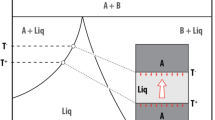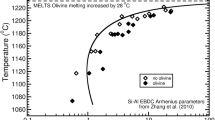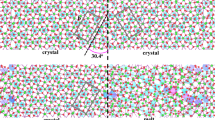Abstract
Numerical simulations of the growth of a large crystal face of plagioclase in response to an instantaneous undercooling below the equilibrium temperature are presented for model granodiorite and basalt melts with varying water contents. The simulations suggest that the anorthite content of plagioclase decreases uniformly from the composition in equilibrium with the bulk melt as undercooling is increased, and that the water content in the melt has little influence on this result. Comparison of the simulations with sharp compositional changes in natural profiles suggests that undercoolings of tens of degrees C can be rapidly imposed on plutonic phenocrysts. Large changes of undercooling most likely result from chilling of the magma and local convection around growing crystals. The observation in experiments that growth rate does not increase rapidly with increasing water content in the starting melting composition can be attributed to the concentration of water at the crystal face during growth; the action of water to reduce liquidus temperature and undercooling has a greater effect on growth rate than its action to increase transport rates. Even at large undercooling, there is no significant increase in temperature at the interface caused by the release of heat of crystallization.
Simulations are presented to illustrate how disequilibrium growth processes due to undercooling can modify the normal zoning profiles expected from fractionation. Assuming that an undercooling is necessary to cause nucleation, normal zoning can result if crystal growth takes place at constant or increasing undercooling, but reverse zoning can occur at decreasing undercooling. Undercooling during growth is controlled by the relative rate of cooling and the rate at which the liquidus temperature is decreased by the accumulation of residual components and volatiles in the melt. Consequently, normal zoning should be promoted by rapid cooling, contemporaneous crystallization of other phases, and absence of volatiles, while reverse zoning should be expected in phenocrysts grown in slowly-cooled melts or in melts where volatiles are concentrated. The zoning patterns found in many plutonic plagioclase crystals suggest that their compositions are in significant disequilibrium with the melt; consequently, they are unsuitable for use in geothermometers.
Approximate calculations suggest that the amount of water concentrated at the surface of growing phenocrysts in plutons can promote local convection. Comparison of simulated and observed oscillatory zoning profiles suggests that oscillatory zoning is not explained by a re-nucleationdiffusion model (Harloff 1927), but is readily explained by periodic local convection.
Similar content being viewed by others
References
Albarede F, Bottinga, Y (1972) Kinetic disequilibrium in trace element partitioning between phenocrysts and host lava. Geochim Cosmochim Acta 35:141–256
Bottinga Y, Kudo A, Weill D (1966) Some observations on oscillatory zoning and crystallization of magmatic plagioclase. Am Mineral 51:792–806
Burnham, CW (1975) Thermodynamics of melting in experimental silicate-volatile systems. Fortschr Mineral 52:101–118
Burnham CW (1979) The importance of volatile constituents. In: Yoder HS (ed) A Fiftieth Anniversary appraisal of Bowen's evolution of the igneous rocks. Princeton University, Princeton, NJ, pp 439–482
Downes MJ (1974) Sector and oscillatory zoning in calcic augites from Mt. Etna, Sicily. Contrib Mineral Petrol 47:187–196
Fenn PM (1977) Nucleation and growth of alkali feldspar from hydrous melts. Can Mineral 15:135–161
Flood H, Knapp WJ (1968) Structural characteristics of liquid mixtures of feldspar and silica. J Amer Ceram Soc 51:259–263
Greenwood HJ, McTaggart KC (1957) Correlation of zones in plagioclase. Amer J Sci 255:656–666
Harloff C (1927) Zonal structure in plagioclase. Leidse Geol Meded 2:99–114
Hess PC (1970) Polymer model of silicate melts. Geochim Cosmochim Acta 35:289–306
Hills ES (1936) Reverse and oscillatory zoning in plagioclase feldspars. Geol Mag 73:49–56
Hopper RW, Uhlmann DR (1974) Solute redistribution during crystallization at constant velocity and constant temperature. J Crystal Growth 21:203–213
Jambon A (1979) Diffusion of water in obsidian. Eos 60:409 (abs)
Kirkpatrick RJ, Robinson GR, Hays JF (1976) Kinetics of crystal growth from silicate melts: Anorthite and diopside. J Geophys Res 81:5715–5720
Kirkpatrick RJ, Klein L, Uhlmann DR, Hays JF (1979) Rates and processes of crystal growth in the system anorthite-albite. J Geophys Res 84:3671–3676
Lindstrom DJ, Lofgren GE, Haskin LA (1979) Experimental studies of kinetic effects on trace element partitioning. Eos 60:402 (abs)
Lofgren, G (1972) Temperature induced zoning in synthetic plagioclase feldspar. In: MacKenzie WS (ed) The feldspars. Univ of Manchester Press, Manchester, pp 362–377
Loomis TP (1979) An empirical model for plagioclase equilibrium in hydrous melts. Geochim Cosmochim Acta 43:1753–1759
Loomis TP (1981) An investigation of disequilibrium growth processes of plagioclase in the system anorthite-albite-water by methods of numerical simulation. Contrib Mineral Petrol 76:196–205
Loomis TP, Welber PW (1982) Crystallization processes in the Rocky Hill Granodiorite Pluton, California: An interpretation based on compositional zoning of plagioclase. Contrib Mineral Petrol 81:230–239
Maaloe S (1976) The zoned plagioclase of the Skaergaard intrusion, east Greenland. J Petrol 17:398–419
Margaritz M, Hofmann AW (1978) Diffusion of Sr, Ba and Na in hydrous melts. Geochim Cosmochim Acta 42:595–606
Rutter JW, Chalmers B (1953) A prismatic substructure formed during the solidification of metals. Can J Phys 31:15–39
Shaw HR (1974) Diffusion of H2O in granitic liquids. In: Hofmann AW, Giletti BJ, Yoder HS Jr, Yund RA (ed) Geochemical Transport and Kinetics. Carnegie Inst Washington Publ 634:139–170
Sibley DF, Vogel TA, Walker BW, Byerly G (1976) The origin of oscillatory zoning in plagioclase: A diffusion and growth controlled model. Am J Sci 276:275–284
Swanson SE (1977) Relation of nucleation and crystal-growth rate to the development of granitic textures. Am Mineral 62:966–978
Smith AL, Carmichael ISE (1969) Quaternary trachybasalts from S.E. California. Am Mineral 54:909–923
Taylor M, Brown GE Jr (1979) Structure of mineral glasses — I. The feldspar glasses NaAlSi3O8, KAlSi3O8, CaAl2Si2O8. Geochim Cosmochim Acta 43:61–76
Vance JA (1962) Zoning in igneous plagioclase: Normal and oscillatory zoning. Am J Sci 260:746–760
Watson EB (1979) The effect of dissolved water on cesium diffusion in molten granite. Eos 60:402 (abs)
Wiebe RA (1968) Plagioclase stratigraphy: a record of magmatic conditions and events in a granite stock. Am J Sci 266:670–703
Author information
Authors and Affiliations
Rights and permissions
About this article
Cite this article
Loomis, T.P. Numerical simulations of crystallization processes of plagioclase in complex melts: the origin of major and oscillatory zoning in plagioclase. Contr. Mineral. and Petrol. 81, 219–229 (1982). https://doi.org/10.1007/BF00371299
Received:
Accepted:
Issue Date:
DOI: https://doi.org/10.1007/BF00371299




